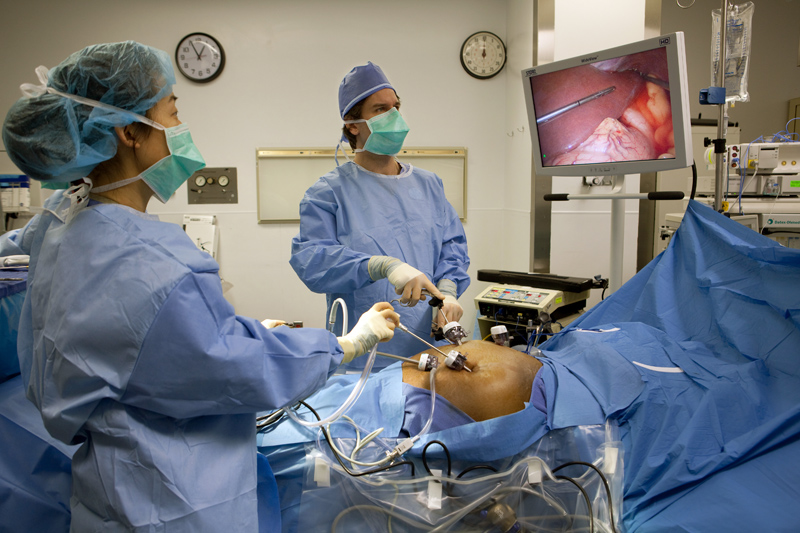Day #9:
My ninth day was spent in the OR again where I watched Dr. Cha perform a gallbladder removal. After watching these surgeries in UH and the Clinic, it is making me a lot more appreciative of the work physicians and nurses do each day behind the scenes for our wellbeing.
Today, I arrived at the Clinic OR at 7:00 AM. Dr. Cha walked me to the break area, where we grabbed masks, headgear, and safety glasses. Then we walked to a perioperative room to check in with the patient before the procedure. The patient stated they were nervous but were ready to start. Dr. Cha and the patient signed a consent form, and we left the room. About 10 minutes later, we made our way to OR 16. The patient was lying on a hospital bed with oxygen tubes and IVs hanging from their mouth and arms. Once everyone got to the room, Dr. Cha signaled that he was ready to start the cholecystectomy (gallbladder removal). The anesthesiologist talked to the patient to calm her down while they started pumping sleepy meds through her IV tube. Eventually, the meds took over, and she was sedated. Here is some context: The gallbladder is primarily responsible for storing bile (used to absorb fats in our food) produced by the liver. An imbalance between the components that make up bile (salts, phospholipids, cholesterol, bilirubin, electrolytes, and water) can force the cholesterol out of the solution. Over time, the cholesterol accumulates and forms a hard mass: a gallstone. While some individuals may be asymptomatic and not require gallstone treatment, others may experience inflamed gallbladders that result in intense pain, necessitating surgical removal. The liver will eventually compensate for the lack of a gallbladder by producing bile constantly. Now, back to OR 16. To start the procedure, Dr. Cha and his resident surgeon made four small incisions laterally across the right and left lower quadrants of the abdomen. Like on day 7, Dr. Cha screwed in a camera port (the camera's feed was displayed around the OR on large monitors), first breaking past the visceral fat layer and then pushing through the muscular abdominal wall until the probe reached the abdominal cavity. The same process was repeated with the other incisions but with smaller ports. Then a nurse insufflated (expanded) the cavity with CO2 gas. Into the smaller ports went a mini scalpel, a cautery tool (used to burn through tissue), and forceps, each attached to long metal rods so that the surgeon could use each tool outside of the body while using the camera to position the tools inside. With the forceps, the liver was held to the roof of the abdominal cavity. Sitting underneath the liver was the gallbladder. Dr. Cha slowly made small incisions using a combination of the scalpel and cautery tool to remove the gallbladder from the liver wall. Once the superficial fat was removed from the bladder, Dr. Cha located a blood vessel and bile duct protruding from the organ. He replaced one of his tools with a staple gun and stapled shut both sides of the vessel to eliminate blood flow. He used his scalpel to remove the smooth muscle vessel between the staple locations. Before removing the gallbladder entirely, it is customary to image the site for surgical errors or locate additional gallstones within the body. A radiology technician entered the room with a large fluoroscopy machine and lead shield. They positioned the machine above the abdomen. Everyone in the room, not wearing a lead vest, crowded behind the shield. While the technician took an X-ray, Dr. Cha sent contrast via a long needle through the abdominal wall and into the bile duct to expose any blockages inside the duct by additional stones. Since the contrast flowed correctly, the procedure continued. Dr. Cha stapled the end of the bile duct closest to the liver and used the scalpel to cut off the other side. Once the gallbladder was removed and positioned beneath the larger camera port, the resident scooped up the bladder with a plastic bag and pulled it through the opening. Then the ports were removed, the incisions sutured, and the gallbladder was taken to pathology, concluding the procedure. Overall, the surgery took about an hour and a half. Dr. Cha and I waited another 45 minutes for his next patient to be brought into OR 15. Comparatively, the next procedure was easier; draining a postoperative infection. This patient had a large abdominal hematoma (collection of clotted blood) removed a few weeks ago. Unfortunately, the surgical site became infected and filled with pus (dead white blood cells). To start the procedure, a surgeon injected local anesthetic into the skin so the patient couldn't feel any pain around the area. Then, two small incisions were made in the abdomen above the infection until they reached a thin, fatty layer above the pus. One of the surgeons pushed a suction tube through the hole until the layer popped, and pus began flowing down the tube and into a collection instrument. Once the flow stopped, the surgeon used his finger and a bottle of saline solution from the other incision to clean the site. Then, a new drain was installed, and the incisions were re-sutured. The procedure was around 25 minutes. The next procedure wouldn't be until later that afternoon, so Dr. Cha and I went our separate ways. I will be with Dr. Bencsath in the OR tomorrow because Dr. Cha is doing clinical visits in Twinsburg.

Comments
Post a Comment